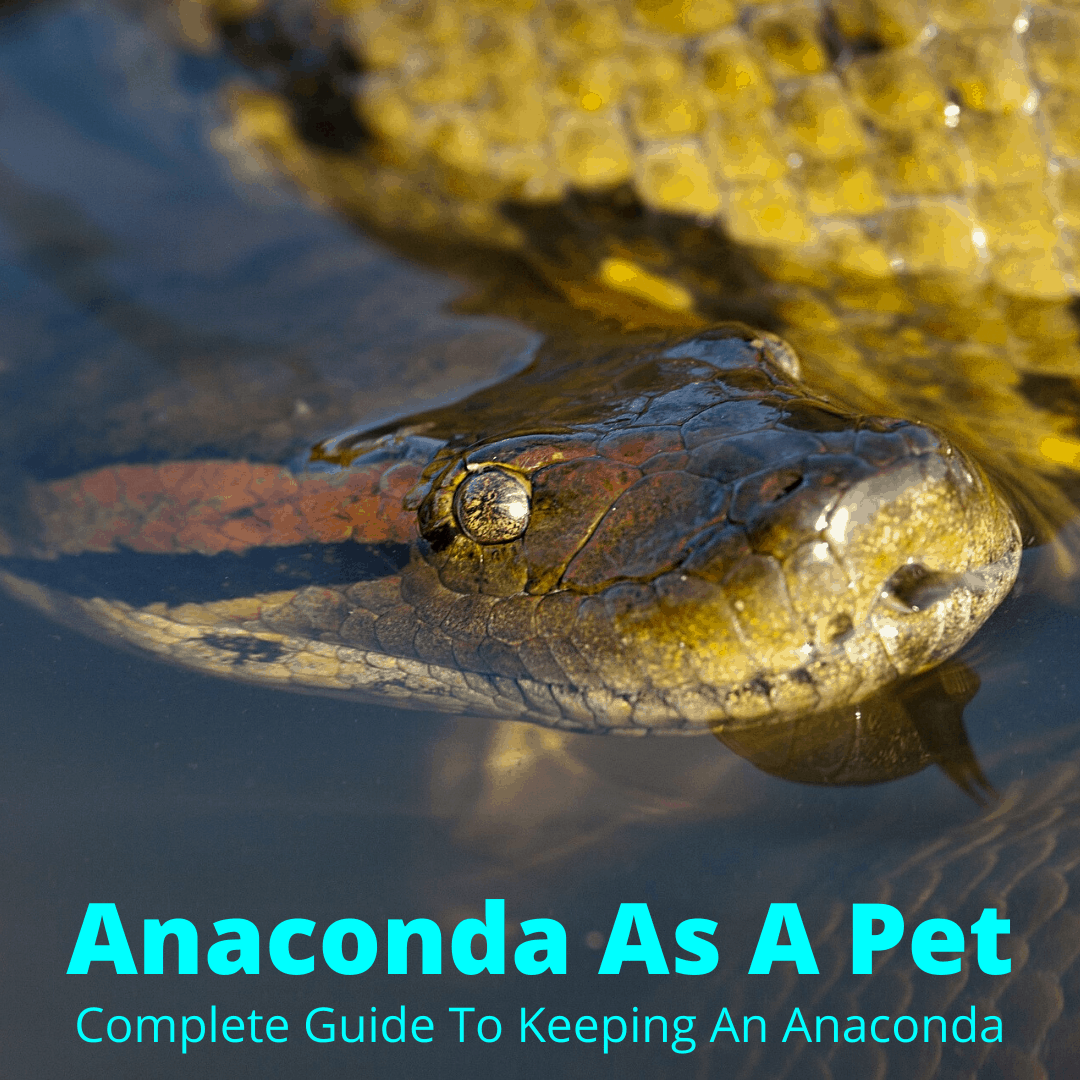
If you’ve never considered the Anaconda as a pet, because of movies like Anaconda, it’s time to reconsider.
Even the largest real-world anacondas don’t get as large as the monsters that hunt humans in Hollywood’s version of the world.
And there are plenty varieties that stay relatively small.
That said the anaconda is still the largest snake in the world. Big ones can grow up to 20 feet long.
That is a far cry from the 50+ foot monsters Hollywood uses to scare us to death. But it’s still humongous.
Even smaller varieties are going to need much more space in your home than a small snake. And setting up their home is expensive.
Does that mean keeping an anaconda as a pet is a bad idea?
Not necessarily. But you need to know what you’re getting yourself into.
Table of Contents
Anaconda As A Pet
Few pets are as cool and impressive as an anaconda. And owning one has other benefits, beyond the cool-factor. But it is not an easy pet to take care of, primarily due to their size.
A High-Maintenance Non-Venomous Serpent
Despite the Anaconda having a bad reputation as a man-eater, they are non-venomous snakes. They make fascinating pets for people with a deep appreciation of serpents and their ways.
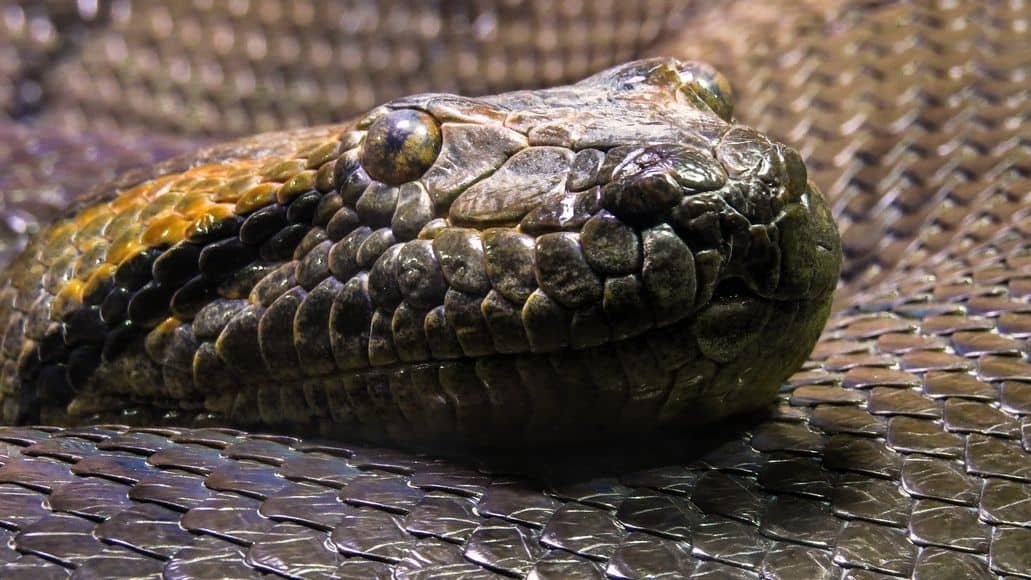
Snakes may seem like low-maintenance pets (and some are), but they generally require a significant amount of care to ensure their health and contentment. If you are interested in keeping a snake as a pet, you need to know exactly how to take care of it.
And that begins with the kind of habitat it requires.
A Room Sized Habitat For This Large Snake
Take note that your Anaconda snake can grow to be anything from 9 to 20 feet in length, with the Yellow Anaconda being the smallest, and easiest to handle. Their large size means that they need a room-sized habitat.
They are rainforest animals, so their large cage is going to require a warm environment with humid air. As a reptile, your Anaconda is going to require a heat gradient, meaning that it will need one side of its enclosure to be warmer.
They are then able to thermo-regulate by moving around the cage to the temperature that suits them best at any given moment.
These snakes have poor eyesight and they navigate their environment through senses of heat and smell.
In the wild, the Anaconda lives in tropical river systems and swamps with a hot, humid climate. The snake likes spending its time in murky waters, so you will certainly also need to provide an appropriately sized swimming pool for your pet.
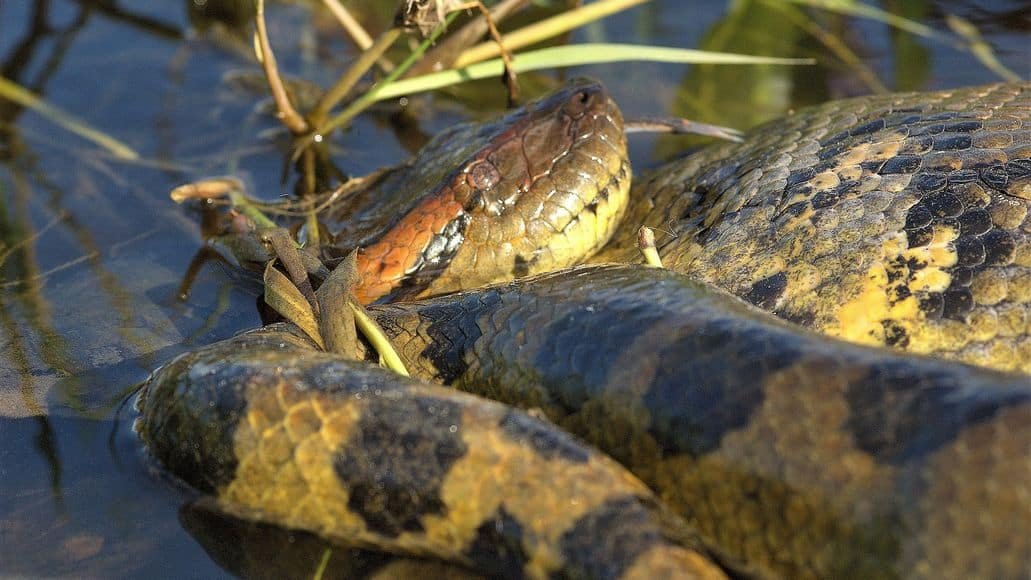
Enclosure Setup
Make sure to do plenty of research before considering this snake as a pet. The initial set up and enclosure for your Anaconda will be costly.
Because of costs and the different sizes of snakes, it can sometimes be difficult finding the best cage for such a large reptile. It is precisely why so many snake-owners opt to build their own home-made snake cages.
Nothing is set in stone when it comes to materials for a snake cage. Snakes are strong creatures and they defecate anywhere, bathe in the pools you provide and also spill water.
You need to think carefully about material choice for cleaning purposes. Wood, glass, and plastic are all options, but with an Anaconda you also have to make sure you have a super strong cage that is impossible to escape from.
Enclosure Size
Young Anacondas can be housed in 50-gallon aquariums or cages like this one.
As your snake grows, you will need to provide it with a cage large enough to house its full size.
You’ll want your snake to be able to stretch out to its full length, if at all possible. Quite frankly, for an anaconda enclosure, the bigger the better. Certainly, a Green Anaconda will need a room-sized enclosures of 75 to 100 square feet.
You may not be able to find a suitably sized Anaconda enclosure and may need to have one custom-built.
Inside The Cage
It doesn’t stop with the enclosure. You also need a bunch of things inside to keep your pat alive and comfortable.
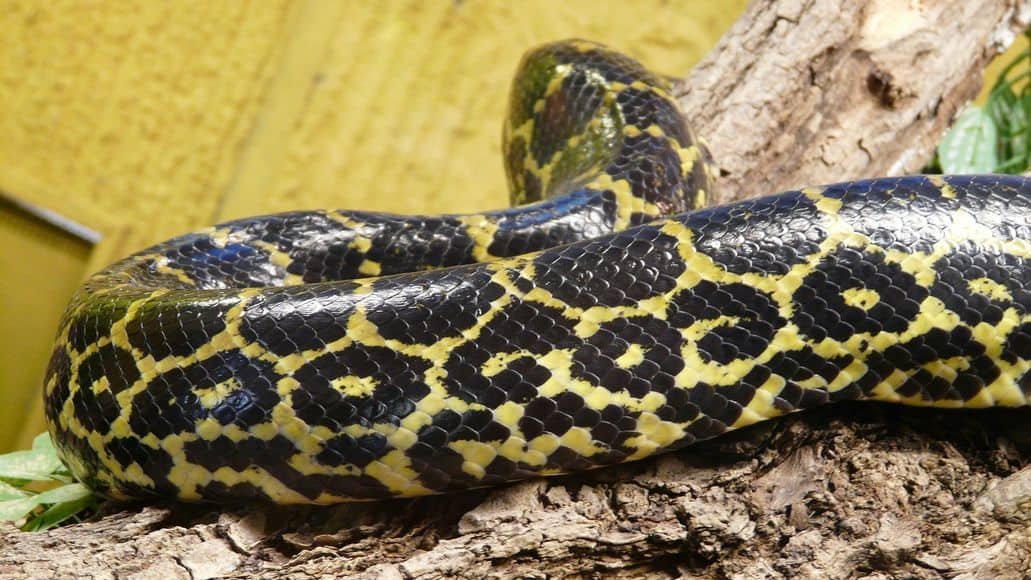
Substrate
The bottom of the enclosure should be covered. When choosing a substrate, there are many, and you can even use things such as newspaper and cardboard. A newspaper is excellent for maintaining humidity and for being odorless.
If you want to go the more ‘professional’ looking route for your snake, you can buy natural substrates. A good example is Exo Terra Plantation Soil tropical substrate which is odor absorbing and heat-treated. It is ideal for humidity-loving reptiles as it controls air humidity levels naturally.
Pool And Filtering
A pool of sorts is imperative for an Anaconda snake. It should be large enough for the Anaconda to fully submerge itself. While they can’t hold their breath as long as many snakes, they can still stay under water for up to 10 minutes.
Water temperature has to be between 76° and 82° Fahrenheit.
Water filtration is absolutely necessary. This is because Anacondas have large feces, and the pool can quickly become murky, unsightly and unhygienic—a breeding place for bacteria.
Filtration is therefore critical and the filter needs to be out of sight of the Anaconda. Filtering is a huge issue and you will need to carefully plan draining systems.
You might want to speak to a snake expert to get tips and advice on the best way to drain the pool and also sanitize it. While the snake is still small you can use a pool like this one:
Obviously, you will need to keep the pool clean at all times.
A Hide
All snakes in the wild spend time ‘undercover’. They like to disappear out of sight under rocks, in caves, and under logs.
A well-sized hide in which the snake can completely coil up is ideal. It’s a natural instinct with snakes, and you need to support their natural behavior by ensuring hiding spots in the cage.
Heat And Lighting
Anacondas require daytime temperatures of 80 to 92°F and a night-time temperature of 75 to 80° F. These heat lamps from Zacro work great for providing heat.
They are 100w black infrared heat lamps that are easy to install and are the ideal 24-hour heat source. The input voltage is AC 90-120V and the full size is 2.95″ by 4.13″.
These lamps are a popular choice because the heating is more natural, like the sun, and they light the enclosure at the same time, which is great for viewing purposes.
You will also need to mist the enclosure twice a day, to keep the substrate moist and to maintain humidity. You can buy programmable misting units for snake enclosures for indoor or outdoor use and for different duration. This article reviews the best humidifying misters.
Anacondas require a period of higher humidity when their shedding cycle begins. The right humidity allows the snake to slough off its skin in one piece as opposed to it breaking of in several smaller pieces.
Miscellaneous Snake Items
There is nothing to stop you from investing in other snake accessories to make your Anaconda’s environment attractive. You may want to forage around outdoors and find a nice large branch for your snake to perch on. Decorative jungle plants, stones, and pebbles can all go towards providing a natural jungle or rain forest appearance for your Anaconda.
Feeding And Diet
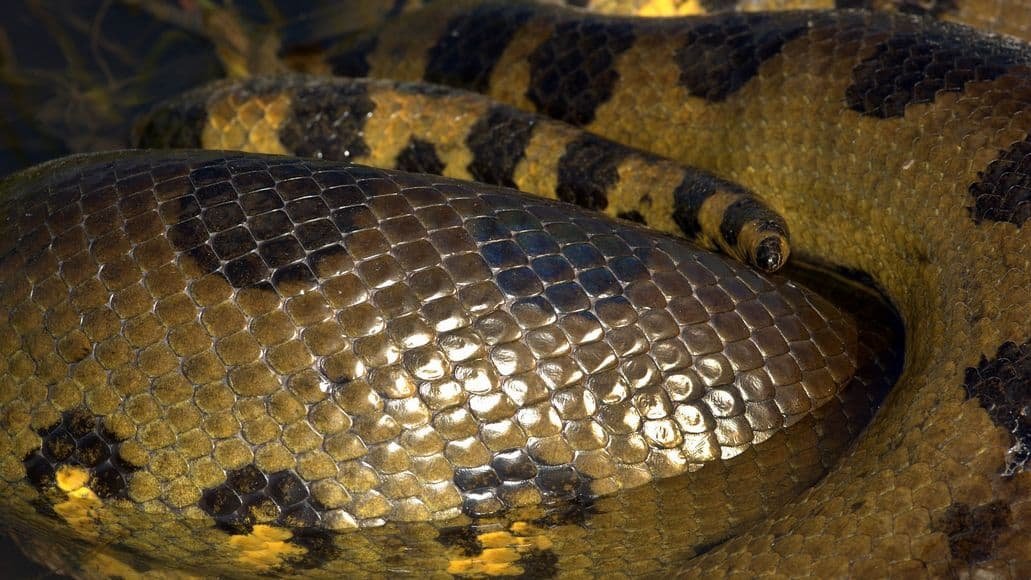
Anacondas are carnivores. in the wild, they eat fish, capybara, rabbits, rodents, and pigs. You can feed hatchlings mice, but adult snakes will need larger animals like rabbits, chickens, and pigs.
Feeding time can be a dangerous time to be near a large constrictor snake so you need to establish a safe feeding method.
Be careful feeding your Anaconda live prey. This is because a rat or a chicken will put up a fight and in captivity, your pet snake can be injured and the wound can become infected.
Dead animals are generally a better option. Snakes in the wild are opportunistic, and will happily feed on any dead animals they come across.
Food can be offered using long-handled tongs or hooks. Juvenile Anacondas can be fed every 7 days on frozen mice. Frozen snake foods like this ensures no hassle or mess:
Packets include 10 to 100 mice in a pack. Frozen mice that are thawed (always thaw them before feeding) are a safe method of feeding your snake.
Adult Anacondas should be fed every 2 to 3 weeks. It’s your responsibility to keep an eye on your snake’s weight. You can adjust feeding times according to seasonal changes and behavior of the snake, bearing in mind that both under and overfeeding can lead to a variety of health issues.
Anacondas As Pets: Final Thoughts
There is no denying that the Anaconda is an amazing and impressive reptile and makes for a unique pet. But legislation is changing in several countries and you may no longer be able to keep these snakes in captivity.
Do research on keeping one of these snakes and whether it is legal to keep one as a pet in your country. It pays to be a responsible snake owner.
You can count yourself lucky to be able to share your life with such an awesome animal. But you need to treat it right. Make sure you learn everything you need to know about keeping these snakes as pets, to avoid any serious mishaps.
Brought up and looked after properly, the yellow and green Anaconda can be a calm pet that is interesting to interact with.
Don’t show off with it when visitors come around. Some people like to boldly grab at it, and the snake doesn’t like behavior like that. It will become defensive and strike out at you. Your visitors may never see you again.
Anacondas are smart and can learn to trust you if you provide them with positive, calm experiences, whether visitors are present or not. We have an article listing 10 incredible anaconda facts, if you are interested in learning more about this amazing serpent.




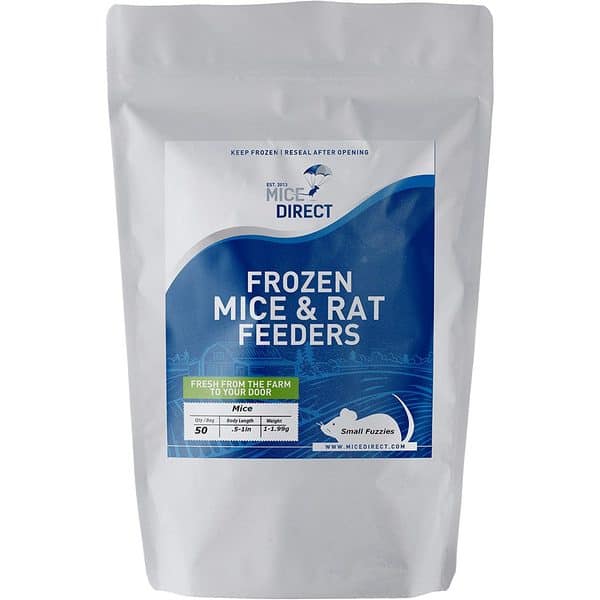
Gregg L. Friedman MD says
Thank you for your article on the proper care of the green anaconda. They reach similar lengths to the Burmese python but they are much heavier than the Burmese python. They also seem to prefer more of an aquatic environment than a Burmese python. By Gregg L. Friedman MD
Sasha Swirl says
I really want to get an anaconda pet after reading this! I always knew snakes were amazing animals but I knew more after this